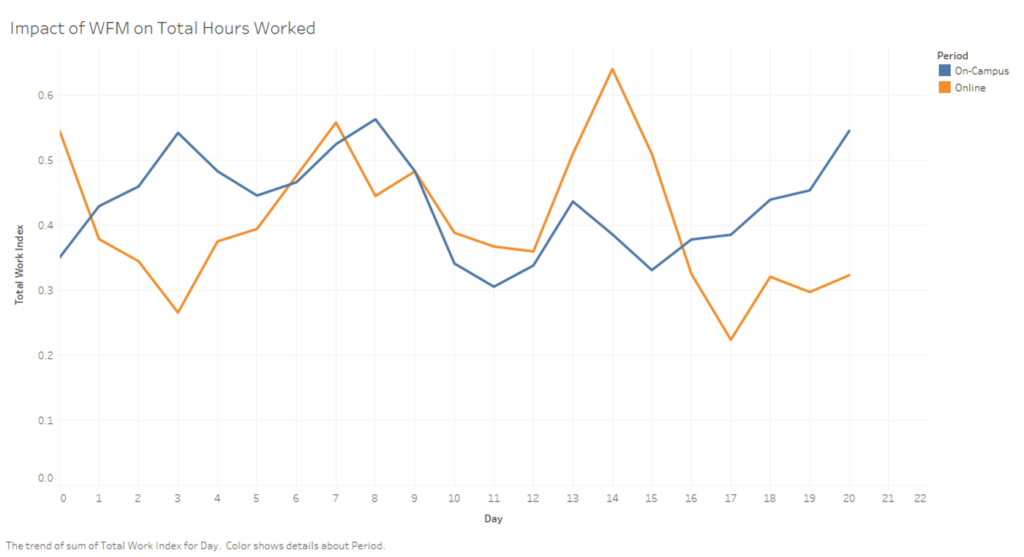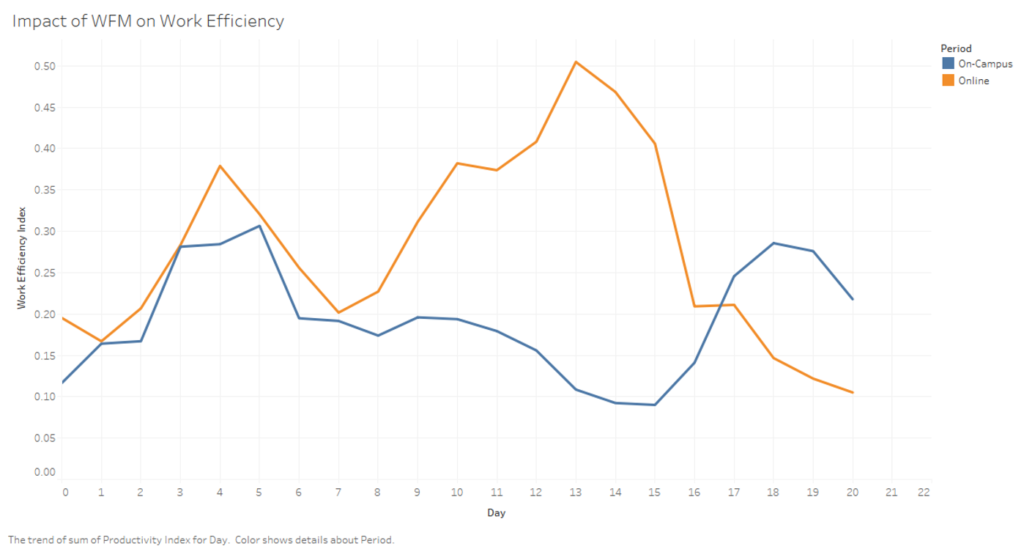Evaluating WFH Productivity in the Age of Covid-19

What expert opinions and analytics data are telling us about what will happen to our productivity in the age of Covid-19
“[Covid-19] will create a productivity disaster for firms,” says Nicholas Bloom, senior fellow at the Stanford Institute for Economic Policy Research (https://news.stanford.edu/2020/03/30/productivity-pitfalls-working-home-age-covid-19/).
It’s worth considering whether Bloom is correct as his statement is a strong departure from his research that actually supports the merits from working from home. In a study published in 2015, Bloom showed that performance increased 13% and employee resignations decreased by 50% in a nine month experiment where 1000 employees in a Chinese travel company worked from home.
However, Bloom believes conditions today are unlike those in his research and will lead to a sharp drop in global productivity. One key difference between the study and the current situation is that parents have to take care of their children while working. “Working from home with your children is a productivity disaster,” Bloom says.
“My 4-year-old regularly bursts into the room hoping to find me in a playful mood shouting “doodoo!” – her nickname for me – in the middle of conference calls.”
These situations are exacerbated by the fact many families do not have separate work offices and have to share spaces during working hours. Lastly, Bloom constructed the study where employees were required to work in-person once a week to promote collaborative thinking and a spontaneous exchange of ideas, which we currently are unable to do in an environment of social distancing.
In order to evaluate Bloom’s research, I compared my own productivity since HBS moved classes online to the period right before spring break where I was still on campus. I evaluated productivity on two levels – total hours worked and efficiency of hours worked. I construct indices to track both and plot them below – higher values correspond to increased total hours and increased efficiency. I compare index values over periods spanning 21 days, adjusted to take into account variations in daily schedules (i.e. day 0 on-campus and day 0 online both correspond to a Monday).
- Takeaway 1: The shift to online learning has not increased total work hours. Over periods spanning 21 days, there are many days where working on-campus led to higher work hours than working online.

- Takeaway 2: Total work efficiency has generally increased since shifting to online learning. I attribute this to the fact I take fewer breaks in between study blocks because there are fewer distractions such as meetings and commuting.

Like the participants in Bloom’s study, I’m experiencing a slight increase in work performance since working from home. This increase is attributable not to total work hours but in the efficiency of those hours worked. I do fit the profile of the research participants in not having kids and having my own room to work from. Bloom’s concern still stands for those with families, however, which I don’t have data for but anecdotal evidence in speaking to classmates and alumni with kids.
In trying to reconcile all this, I arrive at the conclusion that everyone is experiencing WFH a bit differently, and that we should be mindful of those with different circumstances and ready to offer a helping hand. If you’d like to share your views on post or how WFH has been affecting your own productivity, please do comment below!



I think another key mechanic of Bloom’s research is the cultural context, both of the company and the larger society in which it takes place. When I worked in China, I saw a lot of companies where “busy work” was the norm. Productivity was expressed in terms of time spent in the office, not necessarily output. I can also think certain organizations in Canada and the US where this tends to be true (particularly in government). In cases like these, one would expect to see a large increase in productivity because employees are incentivized to complete their work early, and not drag it out throughout the day (as would be the case in their office).
However, for many professionals in high work/high stress roles, I would expect this effect to be much more negligible. I really appreciate you bringing your own data into this as well. Because my days are less structured, I’ve also started collecting data on my work habits in order to optimize for this new environment. It would be interesting to see if this is a common trend…
This was interesting to read, especially with your own personal information! I agree that circumstances for every worker are different, with key factors being dedicated workspaces and childcare. (I find myself distracted enough by cats. I can only imagine children) I am very interested to see if some companies choose to continue to work remotely following the COVID-19 epidemic. After spending the time to develop procedures to work from home, there will be incentives to reduce the fixed costs of office spaces as long as productivity holds.
The variability in workspaces is a key difference that we didn’t have to contend with before. The uniformity of an office creates a more level playing field. As someone who has a 5 month old at home and a wife who works full-time (still going into the office twice a week), the effect on my productivity has been horrendous. I’ve had to cram work into margin periods when my daughter is sleeping. We are also crammed into a one bedroom apartment which doesn’t help. It’d be interesting to see work productivity before and after for each demographic. I’m sure some will benefit and some will be harmed, but the question is how much. I’m also curious at to what employers are doing to see through this temporary difference in productivity, especially for those employees who are struggling with the new situation.
Sarkis, what an insanely rigorous analysis of your own personal work pattern, this is great! I completely agree with everything you write at the end of your blog post: the crisis definitely affects everyone in a very different way and in order to make general conclusions you would have to repeat this analysis for a larger subset of the population.
My big question: how did you quantify your work pattern? I am especially interested in understanding how you measured your own productivity!